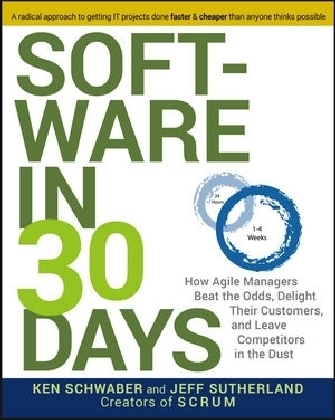
Software in 30 Days
John Wiley & Sons Inc (Verlag)
978-1-118-20666-9 (ISBN)
A radical approach to getting IT projects done faster and cheaper than anyone thinks possible Software in 30 Days summarizes the Agile and Scrum software development method, which allows creation of game-changing software, in just 30 days. Projects that use it are three times more successful than those that don't. Software in 30 Days is for the business manager, the entrepreneur, the product development manager, or IT manager who wants to develop software better and faster than they now believe possible. Learn how this unorthodox process works, how to get started, and how to succeed. Control risk, manage projects, and have your people succeed with simple but profound shifts in the thinking.
The authors explain powerful concepts such as the art of the possible, bottom-up intelligence, and why it's good to fail early—all with no risk greater than thirty days.
The productivity gain vs traditional "waterfall" methods has been over 100% on many projects
Author Ken Schwaber is a co-founder of the Agile software movement, and co-creator, with Jeff Sutherland, of the "Scrum" technique for building software in 30 days
Coauthor Jeff Sutherland was cosigner of the Agile Manifesto, which marked the start of the Agile movement
Software in 30 Days is a must-read for all managers and business owners who use software in their organizations or in their products and want to stop the cycle of slow, expensive software development. Programmers will want to buy copies for their managers and their customers so they will know how to collaborate to get the best work possible.
KEN SCHWABER is a cofounder of the worldwide Agile software movement and cocreator, with Jeff Sutherland, of the "Scrum" technique for building software in 30 days. He is president of Scrum.org, a software consulting firm, and led the process management product revolution of the early 1990s. JEFF SUTHERLAND is the cocreator of Scrum, and was cosigner of the Agile Manifesto, which marked the start of the Agile movement. He has served as vice president of engineering or CTO at eleven software companies, managing the last seven entirely using Scrum, and achieved industry-leading, hyper-productive results. Jeff is the CEO of Scrum Inc., a consulting and training company.
About the Authors xi
Acknowledgments xiii
Introduction xv
Section I Why Every Business in the World Can Produce Software in 30 Days 1
You are probably frustrated with your software organization. You would like it to be quicker, more flexible, understand your needs better, and help you become more profitable. We look at why you are frustrated and how to fix the problem.
1 The Crisis in Software: The Wrong Process Produces the Wrong Results 3
Many software organizations follow a development process that guarantees waste, uncontrolled risk, unpredictability, surprises, and low value. We will investigate why this process was chosen, how it guarantees failure, and look and some organizations that have recovered from it.
2 Scrum: The Right Process Produces the Right Results 17
There is a process that is appropriate for software development. When you get your developers to use it, you will immediately gain productivity, quality, value, control, predictability, and satisfaction. We look at how this happens in this chapter.
3 Try It Yourself: The Pilot 33
You have read our assertion that there is a better way for you to get software developed for you. However, a lot of people have made assertions and taken a lot of your money in the past, with little or no improvement. In this chapter we show you how to prove that our approach works for no money.
4 What Can I Do? 49
You learned how to do better and you’ve tried it yourself. You like the results and you know what to tell the software organization to do. In this chapter, we look at what you can do to help what you experience in the pilot project succeed.
Section II How to Produce Software in 30 Days 55
Having better software developed for your needs is not so much hard as it is different from what you are used to. In this section, we look at a progressively beneficial set of approaches to get you from where you are now to organizational agility.
5 Getting Started with Scrum 57
Our secret sauce for improving your benefits from software is called “Scrum.” Yes, this is the rugby event that keeps the ball moving down the field. We’ll discuss Scrum, how it works, and why it works in this chapter.
6 Scrum at the Project Level 63
Most persistent improvement in software development starts at the project level. You can use Scrum to further prove its utility, or on critically important initiative that must succeed. We’ll explore what you can tell your developers to do after reading this chapter.
7 Develop a Scrum Capability 75
Success often breeds success. As more software initiatives using Scrum succeed, more people will want to get on the wagon. Rather than changing the entire organization, let’s look at how we can set up a software development universe separate from the disappointing, existing department. You can increasingly reap benefits here on an increasing number of projects and releases.
8 Scrum at the Enterprise Level 101
Scrum at a project or release level provides initiative level agility, the ability to rapidly respond to opportunities or rise to challenges. To gain the most significant benefits, Scrum’s empirical approach to software development must be fit into the organization as a whole. We’ll look at how to do this, and why some approaches are short-lived and others persist.
9 Enterprise Transformation: Profound and Persistent Change 107
You want to make your organization leaner, more efficient, and agile on your watch. Even more, you want these benefits and their underlying causes to persist and become the organizational culture. We’ll look at an enterprise change approach for achieving this in this chapter.
10 Scrumming Scrum 119
We devised Scrum for complex problem solving, like software development. We found Scrum a useful technique for managing organizational change, also a complex problem. The same benefits of transparency, waste removal, risk control, and predictability occurred. We’ll look at this use of Scrum in this chapter.
Appendix 1: Terminology 127
We slowly and progressively introduced some new terminology. This appendix is your reference for those terms.
Appendix 2: The Scrum Guide 133
Read the canonical guide to Scrum, its roles, artifacts, and events. This is the bible of Scrum.
Appendix 3: A Playbook for Achieving Enterprise Agility 153
This appendix presents a more detailed plan for enterprise change, as discussed in Chapter 10.
Index 185
| Erscheint lt. Verlag | 1.5.2012 |
|---|---|
| Verlagsort | New York |
| Sprache | englisch |
| Maße | 185 x 231 mm |
| Gewicht | 318 g |
| Themenwelt | Informatik ► Office Programme ► Outlook |
| Wirtschaft ► Betriebswirtschaft / Management | |
| ISBN-10 | 1-118-20666-5 / 1118206665 |
| ISBN-13 | 978-1-118-20666-9 / 9781118206669 |
| Zustand | Neuware |
| Haben Sie eine Frage zum Produkt? |
aus dem Bereich


